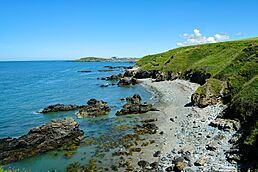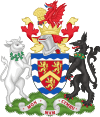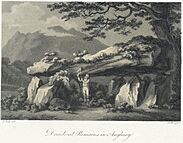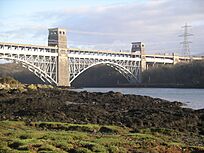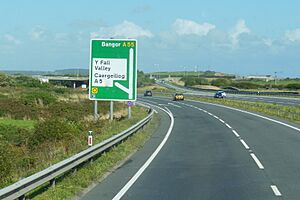Anglesey facts for kids
Quick facts for kids
Isle of Anglesey
Ynys Môn (Welsh)
|
|||
|---|---|---|---|
|
County
|
|||
|
Left to right:
|
|||
|
|||
| Motto(s):
Môn Mam Cymru
|
|||
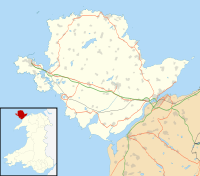 |
|||
| Sovereign State | United Kingdom | ||
| Constituent Country | Wales | ||
| County Council | Isle of Anglesey | ||
| Preserved County | Gwynedd | ||
| Admin HQ | Llangefni | ||
| Largest town | Holyhead (county) Llangefni (island) | ||
| Government | |||
| • Type | Isle of Anglesey County Council | ||
| Area | |||
| • Total | 276 sq mi (714 km2) | ||
| Area rank | 9th | ||
| Population
(2015)
|
|||
| • Total | 70,000 | ||
| • Rank | 20th | ||
| • Density | 250/sq mi (98/km2) | ||
| • Density rank | 17th | ||
| • Ethnicity | 98.1% White | ||
| Welsh language | |||
| • Rank | 2nd | ||
| • Speakers | 55.8% | ||
| Geocode | 00NA (ONS) W06000001 (GSS) |
||
| ISO 3166 code | GB-AGY | ||
Anglesey (pronounced ANG-gl-see), or Ynys Môn in Welsh, is a beautiful island located off the northwest coast of Wales. It's the main part of the county called the Isle of Anglesey. This county also includes Holy Island and some smaller islands. Anglesey is separated from mainland Wales by the Menai Strait and is surrounded by the Irish Sea.
Holyhead is the biggest town on Anglesey, and Llangefni is where the main offices for the county council are located. Anglesey is not very crowded, with about 68,900 people living there. Besides Holyhead, other important towns are Llangefni and Amlwch.
The economy of Anglesey mainly relies on farming, energy, and tourism, especially along its stunning coast. Holyhead is also a busy port with ferries going to Dublin, Ireland. A large number of people in Anglesey speak Welsh, making it an important area for the Welsh language.
Anglesey is the largest island in Wales and the seventh largest in Britain. Its northern and eastern coasts are rugged with cliffs, while the southern and western coasts are generally flatter. The middle of the island has gentle hills. Llyn Alaw is a large reservoir in the north. Many parts of Anglesey's coastline are protected as an Area of Outstanding Natural Beauty.
The island has many ancient sites, like the Bryn Celli Ddu burial chamber. In the Middle Ages, Anglesey was part of the Kingdom of Gwynedd. After King Edward I took control, he built Beaumaris Castle, which is now a World Heritage Site. Two famous bridges, the Menai Suspension Bridge and the Britannia Bridge, connect Anglesey to the mainland.
Contents
What's in a Name?
The English name "Anglesey" might come from an old Viking (Old Norse) word. It could mean "Hook Island" or "Ǫngli's Island." Vikings used this name as early as the 900s.
The Welsh name, Ynys Môn, was first written down by the Romans as Mona. A famous old Welsh saying calls Anglesey "Môn Mam Cymru," which means "Môn, Mother of Wales." This name was given because the island was very good at growing food for the rest of Wales. Other old names for the island include "Shady Isle" and "Isle of the Brave."
Anglesey's Past
Early History
People have lived on Anglesey since the Mesolithic period, about 12,000 years ago, after the last ice age. The oldest sites found are at Aberffraw Bay, dating back to 7,000 BC. The first villages in Wales were built around 4000 BC, and one of these was in Llanfaethlu on Anglesey.
Many large stone monuments, called megaliths, can be found across the island. These show that humans lived here in prehistoric times. Bryn Celli Ddu is a famous burial mound that was used for thousands of years.
Bronze Age to Roman Times
The Bronze Age began around 2200 BC. Many ancient sites, like Castell Bryn Gwyn, were used for a very long time. They started as simple enclosures, then became hillforts in the Iron Age, and were even used during the Roman period.
During the Iron Age, the Celts built round houses. An example of these well-preserved homes can be seen on Holy Island at the Holyhead Mountain Hut Circles. These huts were used for farming even as late as the 6th century.
Modern Anglesey
Roman Rule
Anglesey is famous for its connection to the druids, who were important Celtic religious leaders. In 60 CE, the Roman general Gaius Suetonius Paulinus attacked the island to break the druids' power. He destroyed their sacred places. The Romans fully took control of Anglesey in 78 AD. During their time, they mined a lot of copper on the island. The foundations of Caer Gybi, a fort in Holyhead, are Roman.
Kings and Castles
After the Romans left Britain, pirates from Ireland settled on Anglesey. But a Welsh warlord named Cunedda and his family drove them out.
In the 800s, King Rhodri Mawr united Wales and gave Anglesey to his son, Anarawd ap Rhodri. Anglesey became the home of the House of Aberffraw, a powerful Welsh royal family. The island was a good place to defend, so Aberffraw became the royal court of the Kingdom of Gwynedd.
Over the centuries, Anglesey was invaded by Vikings, Saxons, and Normans. The Vikings even gave the island its English name. Finally, in the 1200s, King Edward I conquered Wales. He built Beaumaris Castle on Anglesey to help control the area. This castle was attacked by Owain Glyndŵr in the 1400s.
20th Century Changes
In the 1900s, Anglesey played a role in both World Wars. During the First World War, it was used to watch for German submarines. In the Second World War, children from cities like Liverpool were sent to Anglesey for safety.
In 1974, Anglesey became part of the larger county of Gwynedd. But in 1996, it became its own separate local authority again, with its own council. New council offices were built in Llangefni.
Anglesey's Landscape
Physical Features
Anglesey is a mostly flat island with some low hills. The highest point is Holyhead Mountain. The Menai Strait, which is about 250 meters wide at its narrowest, separates the island from mainland Wales. Anglesey is about 676 square kilometers in size.
The island has a few natural lakes, mostly in the west, like Llyn Llywenan. There are also two large reservoirs, Llyn Alaw and Llyn Cefni, which supply water. The weather on Anglesey is generally mild because of the Gulf Stream.
Towns and Villages
More people live along the coast of Anglesey than in the middle of the island. Holyhead is the largest town, with over 12,000 people. Other coastal towns include Amlwch, Llanfair-Mathafarn-Eithaf, and Menai Bridge. Llangefni is the largest town in the center of the island and is the county town.
Beaumaris in the east is home to Beaumaris Castle. It's also a popular place for yachting. The village of Newborough in the south has the site of Llys Rhosyr, an ancient court of Welsh princes.
Menai Bridge town grew when the first bridge to the mainland was being built. Near here is Bryn Celli Ddu, an ancient burial mound.
You can also find the village with the longest name in Europe: Llanfairpwllgwyngyllgogerychwyrndrobwllllantysiliogogogoch! Nearby is Plas Newydd, a historic home. Amlwch in the northeast was once a busy copper mining town, thanks to Parys Mountain.
Other towns and villages include Cemaes, Pentraeth, Gaerwen, Dwyran, Bodedern, Malltraeth, and Rhosneigr. The Anglesey Sea Zoo is a fun place to see local marine animals. Sea salt, called Halen Môn, is also made on the island.
Coastal Path Adventures
The coastline of Anglesey is a designated Area of Outstanding Natural Beauty (AONB). This means its beautiful scenery and natural habitats are protected. The Anglesey Coastal Path goes all around the island and is about 124 miles long. It passes through 20 towns and villages, starting at St Cybi's Church, Holyhead.
Anglesey's Economy
Today, tourism is the biggest part of Anglesey's economy. Many people visit the island for its beautiful beaches and coastal activities. Farming is also very important, with local dairy farms being very productive.
Historically, there was an aluminum factory in Holyhead, but it closed in 2009. Anglesey also had the Wylfa Nuclear Power Station, which stopped producing power in 2015. The island is now looking into more green energy, with three wind farms on land and plans for tidal-flow turbines.
RAF Valley is an Air Force base on the island, which provides jobs for about 500 civilians. Smaller businesses are found in industrial parks in places like Llangefni. Holyhead is a major port for ferries traveling between Britain and Ireland.
Nature and Wildlife
Anglesey has many important wetland areas and lakes that are protected. These places are home to a wide variety of birds. For example, the Malltraeth Marshes are known for their bird populations. The cliffs at South Stack near Holyhead are nesting sites for many seabirds like puffins and guillemots.
Anglesey is also home to two of the UK's remaining groups of red squirrels, found in Pentraeth and Newborough.
Most of Anglesey's coastline is an Area of Outstanding Natural Beauty (AONB). This helps protect the island's stunning coastal scenery and habitats. The AONB covers about a third of the island.
Many parts of Anglesey's nature are even more protected by UK and European rules. These include:
- 6 Special Areas of Conservation (cSACs)
- 4 Special Protection Areas (SPAs)
- 1 National Nature Reserve
- 26 Sites of Special Scientific Interest (SSSI)
These areas support various wildlife, including harbour porpoises and marsh fritillary butterflies. Popular activities like sailing, cycling, and walking are enjoyed here, which also help the local economy.
Culture and Events
Anglesey has hosted the National Eisteddfod, a major Welsh festival of poetry, music, and dance, several times.
The island is part of the International Island Games Association. Anglesey has won medals in sports like gymnastics and sailing at these games.
The annual Anglesey Show is held every August. Farmers from all over the country bring their animals to compete. The island also hosts Gottwood, an electronic music festival.
You can listen to local radio stations like Capital Cymru and Môn FM. Anglesey has also been featured in TV shows, including the Netflix series Free Rein and the BBC series Anglesey: Island Lives.
The Welsh Language
Anglesey is a strong area for the Welsh language. According to the 2021 census, about 55% of people on the island speak Welsh. While the percentage has gone down over the years, Welsh is still the main language in some areas, especially in the center of the island around Llangefni.
The island's five secondary schools have different numbers of Welsh-speaking students. For example, at Ysgol Gyfun Llangefni, most students speak Welsh as their first language.
Anglesey's Rocks
The rocks of Anglesey are very old and complex, making it a popular place for geology students to visit. The island's surface is made up of ancient rocks from the Precambrian period.
A special type of rock called Serpentine (also known as Mona Marble) is found near Llanfair-yn-Neubwll. Anglesey is also the only place in the UK to have certain types of sediments from the Middle Miocene era.
Because of its amazing geological history, Anglesey was recognized as a European Geoparks Network member in 2009 and a Global Geoparks Network member in 2010, under the name GeoMôn.
Places to Visit
- Anglesey Motor Racing Circuit
- Anglesey Sea Zoo near Dwyran
- Beautiful bays and beaches like Benllech, Cemlyn, Red Wharf, and Rhosneigr
- Beaumaris Castle and Gaol (old prison)
- Cribinau – a small island with a 13th-century church
- Elin's Tower (Twr Elin) – a bird reserve and the lighthouse at South Stack near Holyhead
- Llanfairpwllgwyngyll, one of the longest place names in the world
- Malltraeth – a great place for birdwatching
- Moelfre – a charming fishing village
- Parys Mountain – an ancient copper mine
- Penmon – with its old priory and dovecote
- Skerries Lighthouse
- Stone Science Museum – a private fossil museum near Pentraeth
- Swtan longhouse and museum – a traditional Welsh house
- Working windmill – Llanddeusant
- Ynys Llanddwyn (Llanddwyn Island) – a tidal island
- St Cybi's Church – a historic church in Holyhead
Famous People from Anglesey
Born in Anglesey
- Tony Adams – actor
- Dawn French – actress and comedian
- Hugh Griffith – Oscar-winning actor
- Aled Jones – singer and TV presenter
- William Jones – mathematician, who first used the symbol for pi (π)
- Julian Lewis Jones – actor
- Owain Tudor – a Welsh nobleman whose grandson became King Henry VII of England.
- Kyffin Williams – a famous landscape painter
- Andy Whitfield – actor
Lived in Anglesey
- Taron Egerton – actor
- Wayne Hennessey – footballer (goalkeeper for Wales)
- Ian "Lemmy" Kilmister – lead singer of the band Motörhead
- George North – Wales rugby union international
- Prince William, Prince of Wales and his wife Catherine, Princess of Wales lived here for a few years.
Schools on Anglesey
There are five secondary schools on Anglesey:
- Ysgol David Hughes, Menai Bridge
- Ysgol Gyfun Llangefni, Llangefni
- Ysgol Syr Thomas Jones, Amlwch
- Ysgol Uwchradd Bodedern, Bodedern
- Ysgol Uwchradd Caergybi, Holyhead
The island also has 50 primary schools.
Getting Around Anglesey
Anglesey is connected to the mainland by two famous bridges: the Britannia Bridge (carrying the A55 road) and the Menai Suspension Bridge (carrying the A5 road). There are also roads that go around the island.
The island has six railway stations, including Holyhead, Valley, and Llanfairpwll. You can catch trains to places like London, Manchester, and Cardiff.
Anglesey Airport used to have flights to Cardiff, but these were stopped. Now, traveling between Cardiff and Anglesey by road or rail takes over four hours.
The port of Holyhead is very busy, with over two million passengers each year. Ferries from Holyhead sail to Dublin in Ireland, making it a key link between Britain and Ireland.
Sports and Fun
Anglesey has its own team, Ynys Môn, that competes in the Island Games. They have won medals in sports like gymnastics, sailing, and shooting.
Football is popular on Anglesey. The Ynys Môn men's team won gold at the 2019 Inter Games Football Tournament when Anglesey hosted the event. There are many local football clubs across the island.
Llangefni RFC is the island's top rugby team.
Every September, the Anglesey Festival of Running takes place, with races for different distances, including a marathon.
The Anglesey Circuit (Trac Môn) is a racing track that opened in 1997. It hosts many motorsport events throughout the year.
Cricket clubs have been around since the 1850s, and sailing is also a popular sport, with the Royal Anglesey Yacht Club hosting an annual regatta.
For swimming, the Menai Strait hosts two open-water swimming events each year. There's also a swimming pool at Plas Arthur Leisure Centre in Llangefni.
See also
 In Spanish: Anglesey para niños
In Spanish: Anglesey para niños


